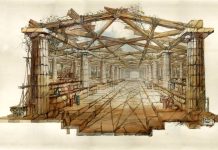Population growth, labor productivity and well-being are the three factors that formed the basis for the enormous volumes of construction that took place in Europe in the nineteenth and twentieth centuries. At the same time — and this is one of the manifestations of the social changes that took place in industrial societies — architecture acquired the status of a profession. England was in the vanguard here, which is proved, among other things, by the birth of professional associations.
In 1834, the organization that became the predecessor of the current Royal Institute of British Architects (RIBA) was founded and the foundation of the library and archives collection was laid under the auspices of RIBA13. This was soon followed by the creation of the Royal Institute of Architects of Ireland (1839), Maatschappij tot Bevordering der Bouwkunst (Society for the Promotion of Architecture in the Netherlands, 1842) and the first of a number of local architectural associations in Belgium — Koninklijke Maatschappij der Bouwmeesters van Antwerp (Royal Society of Architects Antwerp, 1848).
In the period from the middle of the nineteenth century to the first quarter of the twentieth, professional organizations of the same kind arose throughout Europe, mostly they operated at the national level, sometimes at the regional level, in some cases at the local level. In part, they assumed the functions of lawyers, but the desire to unite with colleagues and keep up with the latest achievements in their field also played a well-known role in the activities of their members. Many of these professional organizations published their own magazines, organized lectures, conducted excursions, even organized exhibitions and competitions of projects among their members, with a view to improving the level of professional training. The result of their activity was also the acceleration of knowledge exchange.
At the same time, architectural education was institutionalized and acquired the character of a professional one. It, like the architecture itself, has a long history, some institutions have existed for centuries. Among such institutions are the Ecole des Beaux-Arts of Paris (School of Fine Arts), the successor of the Royal Academy of Painting and Sculpture, founded in 1648, as well as the architectural school at the Royal Danish Academy of Fine Arts, whose history dates back to 1754, when it was announced the creation of the Kongelige Danske Skildre Billedhuggerog Bygnings Academie (Danish Royal Academy of Painting, Sculpture and Architecture, Copenhagen). However, most architectural schools were established in the nineteenth century, and architects in some countries discovered access to academic education only in the twentieth century. Iceland was one of the last in this series: the Icelandic Academy of Arts was founded in 1999.
In the nineteenth century, institutionalized education gradually assumed the function of transferring knowledge from teacher to student in the process of daily work practice. But even in the twentieth century, there were still architects who did not have an official education, but came to architecture through practicing a craft, another art form or through self-education. In many countries, however, this path has always been difficult due to the mutual support of professionals. Today, independent entry into architecture is almost impossible, especially in the countries of the European Union.
The Royal Academy in Delft (founded 1842), designed to train future civil engineers, and the School of the Architectural Association in London (founded 1847) are just two examples of educational institutions that arose in Europe in the middle of the nineteenth century. Already in the nineteenth century, two trends were traced in architectural education (they persist to this day): the minimum number of courses is devoted to the study of academic art, the maximum time is allocated to technically oriented courses.



















